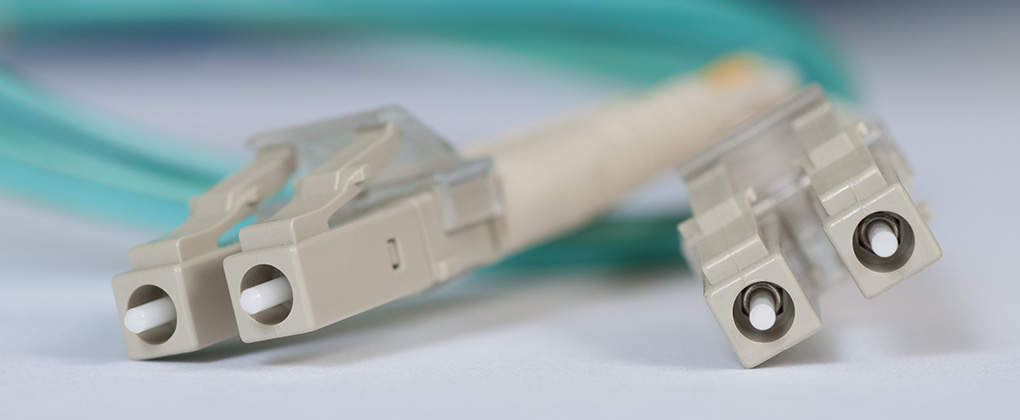Decisions, decisions: OM3 vs OM4 Multimode Fiber
Published by Cablesys on Jun 12th 2018
OM3 Versus OM4 Multimode Fiber
There is a difference between OM3 and OM4 multimode fiber (MMF) optic cables. The ongoing evolution of technologies in servers and storage devices is pushing the need for increased data rates. As a result, fiber optic cables are evolving to stay ahead of the demand in bandwidth. This article will address the differences in speed, distance, physical characteristics, and price.

Overview
OM3 and OM4 fibers are laser-optimized with a 50/125 core, which are made to comply with the ISO 11801 Standard. The OM3 fiber specs indicate that OM3 is particularly made for 10 Gb/s transmission speed, but it is also compatible with and can function under 40 Gb/s and 100 Gb/s. OM4 fiber is the improved version of OM3 fiber. OM4 fiber is mainly used for Ethernet of 10G, 40G, and 100G. OM3 and OM4 fiber optics have a minimum of 2000 MHz*km EMB (Effective Modal Bandwidth or laser bandwidth) and 4700 MHz*km EMB respectively. This means that OM3 can move 2000 Megahertz of data up to 1 kilometer, and OM4 can move 4700 Megahertz of data up to 1 kilometer. For both OM3 and OM4, the EMB is most effective when the distance remains at 1 kilometer or under; over 1 kilometer will slow transmission speed and distance. Regarding compatibility, OM4 is entirely backwards compatible with OM3 fiber optics. The chart below provides detailed information on minimum modal bandwidth of OM3 and OM4 fiber.
| Fiber Type | Overfilled launch bandwidth | Effect laser launch bandwidth | |
|---|---|---|---|
| 850 nm | 1300 nm | 850 nm | |
| OM3 | 1500 | 500 | 2000 |
| OM4 | 3500 | 500 | 4700 |
What is the Difference in Speed?
OM3 multimode fiber is specifically made for 10G Ethernet transmission. This usually makes it the prime option for 10 Gigabit Ethernet over multimode fiber applications. If a project requires an extended transmission distance, OM4 multimode is a fitting option. Furthermore, OM3 and OM4 fibers both support speeds of 40 Gb/s and 100 Gb/s. Through the usage of parallel-optics transmission technology, 40G and 100G Ethernet can transmit and receive data simultaneously, and over multiple fiber optics. The 40G interfaces are 4x10G channels on four fibers per direction, then OM3/OM4 cable terminated with 8/12 fiber MTP/MPO connector can be used for 40 Gb/s transmission. 100G interfaces are 10x10G channels on 10 fibers per direction, then OM3/OM4 cable terminated with 24 fiber MTP/MPO connector are supposed to support 100 Gb/s.
What is the Difference in Multimode Distance?
OM3 and OM4 multimode fibers are compatible with 1GbE, 10GbE, 40GbE, and 100GbE applications, but their transmission distance depends. The chart below displays the maximum transmission distance of OM3 and OM4 fibers under different transmission speeds. Based on the specific 10 Gb/s speed, OM4 fiber projects over a longer distance than OM3 fiber. But, there is still a debate about the when it pertains to maximum transmission distance of OM4 under 10G. As a general rule, it is recognized as 400m. Nevertheless, it can reach 500m, even 550m, if ultra-high quality OM4 fiber is installed.
| Fiber Type | 1G | 10G | 40/100G |
|---|---|---|---|
| OM3 | 1 km | 300 m | 100 m |
| OM4 | 1 km | 550 m | 150 m |
What is the Difference in Color?
An aqua jacket is defined as a laser-optimized OM3 and OM4 multimode fiber optic cable. Although both fibers are different, it is hard to distinguish between them when starting from the front of the panel where all the adapters are the same color. To combat this, a violet OM4 fiber, known as Erika Violet, has been introduced. But, the Erika Violet color is not universal yet; it has only been adapted in Europe and few American companies. Currently, Cablesys only offers the standard OM3 and OM4 fiber versions that are protected with the aqua colored outer jacket.
What is the Difference in Price?
OM3 fiber is roughly twice as inexpensive as OM4 fiber, due to the manufacturing process and constant shift in the market. OM3 has a lower price because production volume is higher for this fiber type. Cost is not only dependent on the above factors; it is based upon the structure of the cable as well (ex. loose tube, tight buffered, etc.). Therefore, fiber products with a smaller cable volume, such as fiber patch cords and fiber patch panels, are essentially lower in cost.
Which Fiber is the Right Choice?
If higher data rates are required to support the network or a network upgrade is anticipated in the near future, the best choice is laser optimized OM3 or OM4 fiber optic cable. OM3 cable allows broad options for future applications, and it allows for more flexibility in future budgets. OM4 fiber optic cable provides better transmission for longer distances in cases that it might be necessary. Cablesys offers a wide spectrum of OM3 and OM4 fiber cables at competitive prices, for all multiple variations such as LC, SC, ST, FC, and MTP/MPO connectors. They are tested to the highest fiber optic standard to guarantee premium quality. In addition, Cablesys offers cable customization to fit the specifics of any project or workspace need. This is an alternative option for projects that require cables outside of our standard selection.
